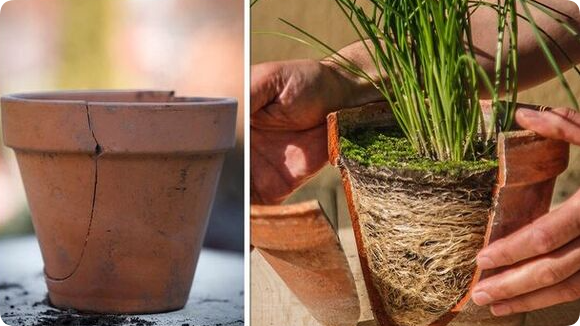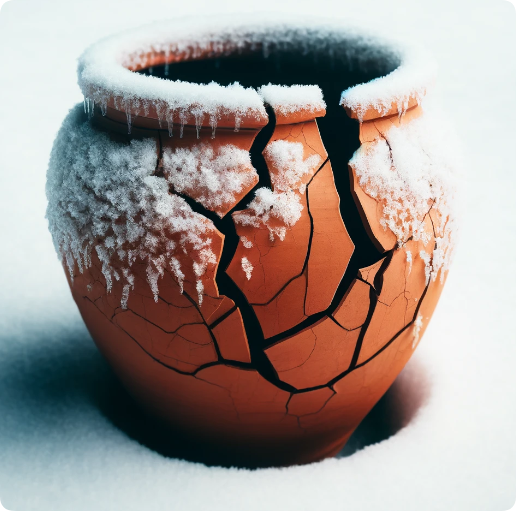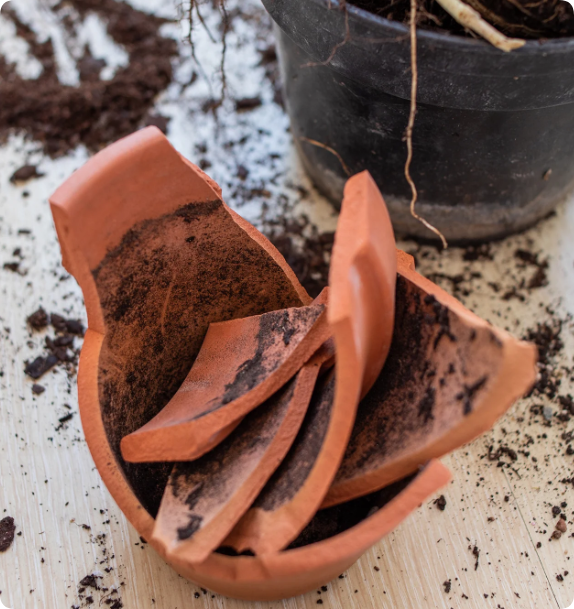How do you keep terracotta from cracking?
Terracotta pots, known for their breathability and rustic aesthetic, are a popular choice among both hobby gardeners and professional landscapers. However, these pots can be prone to cracking, especially in extreme weather conditions or under improper care. For B2B buyers like garden retailers, landscape designers, or plant nurseries, understanding how to minimize the risk of terracotta pots cracking is crucial to ensuring customer satisfaction and reducing product returns. In this article, we will explore the causes of terracotta cracking and offer practical tips on how to prevent it, from selection to storage.
1. Understanding the Nature of Terracotta
Terracotta is a type of clay that has been used for centuries to create various pottery products, including plant pots. The natural composition of terracotta makes it porous, which allows air and moisture to pass through the material, making it ideal for plant growth. However, this same porosity also makes terracotta susceptible to cracking when exposed to temperature fluctuations or when water is absorbed and subsequently frozen within the material.

Key properties of terracotta:
- Porosity: Allows water and air exchange, but also increases vulnerability to cracking.
- Clay composition: Made from a mix of minerals and fine particles, giving it its characteristic reddish-brown color.
- Firing process: Terracotta pots are fired at relatively low temperatures compared to other ceramic types, which leaves them with their porous structure but also less resistant to mechanical stress.
For B2B buyers, understanding these properties is essential when considering terracotta as a product offering. Proper knowledge ensures that you select high-quality terracotta with fewer defects, reducing the risk of cracking during transportation, display, or customer use.
2. Causes of Terracotta Cracking
Before diving into prevention techniques, it’s crucial to identify the common causes of terracotta cracking:
a) Water Absorption and Freezing
One of the most common reasons terracotta pots crack is due to water absorption. The porous nature of terracotta allows water to seep into the clay. When temperatures drop, this water expands as it freezes, causing stress on the material, which leads to cracking. This is especially common in colder climates where pots are exposed to freezing temperatures outdoors.
b) Rapid Temperature Changes
Another cause of cracking is thermal shock. When terracotta pots are subjected to rapid changes in temperature, such as being moved from a warm indoor space to a freezing outdoor environment, the clay cannot expand or contract evenly, leading to fractures or cracks.

c) Physical Impact
Terracotta pots are also more fragile compared to other materials like plastic or resin. A simple knock or fall can lead to a crack or chip. For B2B buyers, this means that shipping and handling must be carefully managed to avoid product damage before it reaches the consumer.
d) Poor Manufacturing Quality
Lower-quality terracotta pots may have inconsistencies in the clay composition or improper firing, which weakens the material. B2B buyers should pay attention to the supplier’s manufacturing process, ensuring that the terracotta pots they purchase are made with high-quality clay and fired under controlled conditions.
3. How to Prevent Terracotta Cracking
For B2B purchasers, preventing terracotta from cracking involves both selecting the right products and advising end-users on proper care. Below are several strategies to reduce the likelihood of cracking.
How to Prevent Pottery Clay from Cracking While Drying
a) Opt for High-Quality Terracotta
When sourcing terracotta pots, it’s essential to work with reputable manufacturers who use high-grade clay and have consistent firing processes. High-quality terracotta will have fewer air pockets and impurities, which are often responsible for cracks.
At Hale Planter, we pride ourselves on using premium-grade clay and employing strict quality control measures to ensure that every pot is well-constructed and durable. As a B2B buyer, partnering with trusted suppliers like us ensures that you offer your customers the best possible products.
b) Advise Customers to Seal Their Pots
For customers in regions with colder climates, advising them to seal the inside of their terracotta pots can help prevent water absorption, reducing the risk of freeze-related cracking. Sealants such as water-based polyurethane or acrylic sealers can be applied to the inside of the pot to create a barrier, preventing moisture from penetrating the clay.
c) Proper Winter Storage
If your customer base is in areas with harsh winters, it’s critical to inform them about proper storage. Terracotta pots should be moved indoors or stored in a dry, frost-free location during the winter months to prevent freezing and cracking. For larger pots that can’t be moved, advising your clients to cover them with waterproof material can also protect them from frost damage.
d) Temperature Management
Terracotta pots are best suited for mild climates. If your B2B customers are in regions with significant temperature variations, you should recommend pots that are more resistant to extreme weather. Alternatively, suggest keeping plants in terracotta pots indoors or under sheltered environments when temperatures fluctuate drastically.
e) Protective Packaging for Shipping
For B2B buyers handling large shipments, protecting terracotta during transportation is key to minimizing breakage. Ensure that your supplier uses protective packaging such as foam padding, bubble wrap, or custom-designed cartons to reduce the risk of impact damage during shipping. Offering advice to your logistics team or partners on best practices for handling terracotta pots can save you from receiving cracked pots and dealing with customer returns.

4. Post-Sale Care Instructions for Clients
As a B2B supplier, one way to enhance your service offering is to provide clients with detailed care instructions for their end customers. By including a care guide with terracotta pots, you can help customers understand how to maintain their pots and avoid cracking, which in turn reduces the likelihood of product returns and increases customer satisfaction.
Sample care tips for terracotta pots:
- Water sparingly: While terracotta is great for plants that prefer drier soil, it’s important to ensure that excess water doesn’t accumulate and cause the pot to become waterlogged.
- Use pot feet: Raising terracotta pots off the ground using pot feet allows for better drainage and prevents water from pooling underneath the pot.
- Avoid drastic temperature changes: Educate customers about the dangers of moving pots from a warm indoor environment to freezing outdoor conditions.
- Seasonal storage: For climates with cold winters, it’s crucial to store terracotta pots indoors during the offseason.
5. Conclusion
Terracotta pots bring a unique charm and functionality to gardening, but without proper care, they can be prone to cracking. For B2B purchasers, offering high-quality terracotta pots from reputable suppliers like Hale Planter ensures your customers receive durable, well-made products. Furthermore, by providing them with care tips and proper maintenance advice, you can reduce product returns and increase overall satisfaction. Remember to select high-quality pots, seal them if necessary, store them properly in winter, and handle them with care during transport to keep terracotta pots from cracking.
At Hale Planter, we are committed to delivering top-notch terracotta pots that combine beauty with durability. As your trusted partner, we help you meet your procurement needs while ensuring that your customers receive high-value, long-lasting products.
This article offers a comprehensive guide for B2B purchasers on preventing terracotta pots from cracking, combining product insights with practical care and handling advice. It positions Hale Planter as a reliable source for high-quality terracotta pots while highlighting key strategies to mitigate cracking risks.

